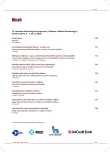Drugs Influencing Bone Metabolism in Diabetic Patients
Authors:
V. Palička
Authors‘ workplace:
Ústav klinické biochemie a diagnostiky Lékařské fakulty UK a FN Hradec Králové, Osteocentrum, přednosta prof. MUDr. Vladimír Palička, CSc.
Published in:
Vnitř Lék 2009; 55(4): 368-370
Category:
Overview
A significant improvement in the knowledge of physiology, pathophysiology and pathobiochemistry of bone metabolism has enhanced the understanding not only of regulatory mechanisms of bone remodelation in adulthood but also of the dysfunction of such regulatory processes with other diseases. In the pathophysiology of metabolic bone disease in diabetic patients, attention is currently being focused on the method in which the differentiation of mesenchymal stem cells in osteoblasts, or adipocytes is regulated. The key role of PPAR‑ γ, its activation or activity inhibition and thus also the directing of the differentiation in fat cells or osteoblasts is especially important in diabetic patients. Thiazolidinediones, in particular of the rosiglitazone type, have a positive impact on increased tissue sensitivity to insulin built on the activation of PPAR‑ γ. Therefore, they can provoke the image of an aging bone in case of prolonged administration. Nevertheless, many factors contribute to the causes of increased fragility of bones in diabetic patients, both directly and indirectly – AGE, changes in insulin and IGF‑I concentrations, renal dysfunctions, chronic inflammatory processes and impaired immunity. The treatment of osteoporosis in diabetic patients does not principally differ from the treatment of postmenopausal osteoporosis.
Key words:
osteoporosis – diabetes mellitus – PPAR – therapy
Sources
1. Duque G. Bone and fat conection in aging bone. Curr Opin Rheumatol 2008; 20: 429–434.
2. Hamdy NAT. Osteoporosis: Other Secondary Causes. In: Primer on the Metabolic Bone Diseases and Disorders of Mineral Metabolism. 7th ed. Washington DC: American Society for Bone and Mineral Research 2009: 276–279.
3. Lazarenko OP, Rzonca SO, Hogue WR et al. Rosiglitazone induces decreases in bone mass and strenght that are reminiscent of aged bone. Endocrinology 2007; 148: 2669–2680.
4. Lazarenko OP, Rzonca SO, Suva LJ et al. Netoglitazone is a PPAR‑gamma ligand with selective effects on bone and fat. Bone 2006; 38: 74–84.
5. Meier C, Kraenzlin ME, Bodmer M et al. Use of thiazolidinediones and fracture risk. Arch Intern Med 2008; 168: 820–825.
6. Takada I, Kato S. A New PPAR‑ γ Function in Bone. IBMS BoneKEy 2008; 5: 258–261.
7. Valcourt U, Merle B, Gineyts E et al. Non‑enzymatic glycation of bone collagen modifies osteoclastic activity and differentiation. J Biol Chem 2007; 282: 5691–5703.
8. Valdivielso JM, Fernandez E. Vitamin D receptor polymorphisms and diseases. Clin Chim Acta 2006; 371: 1–12.
9. Wan Y, Chong LW, Evans RM. PPAR‑ γ regulates osteoclastogenesis in mice. Nat Med 2007; 13: 1496–1503.
Labels
Diabetology Endocrinology Internal medicineArticle was published in
Internal Medicine

2009 Issue 4
Most read in this issue
- Target Values of Blood Pressure in Patients with Diabetes Mellitus
- Drug Interactions of Selected Drugs Used by Patients with Diabetes Mellitus
- Options of Hormonal Contraceptives and Substitution in Female Diabetic Patients
- Insulin Sensitizing Drugs
